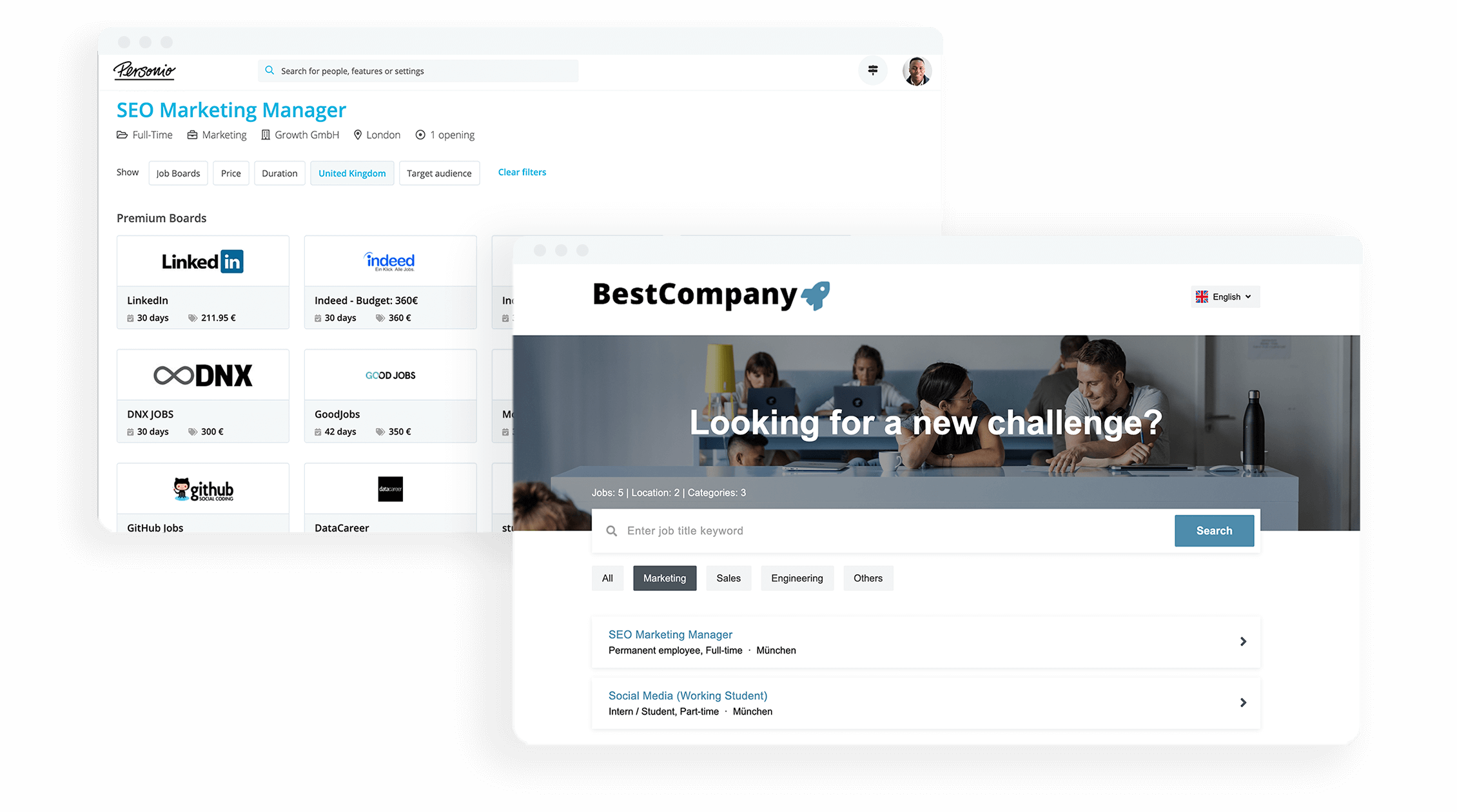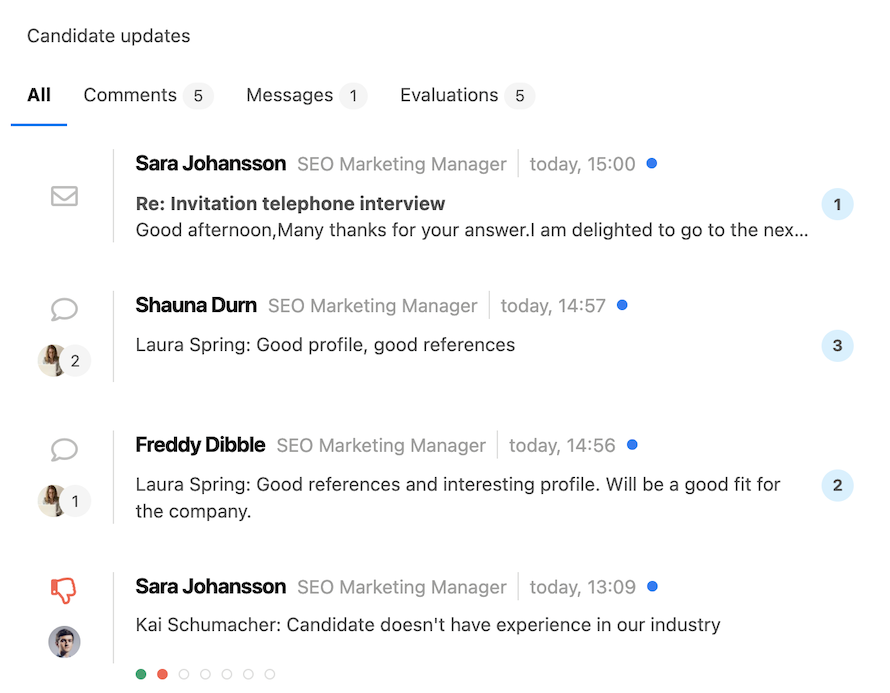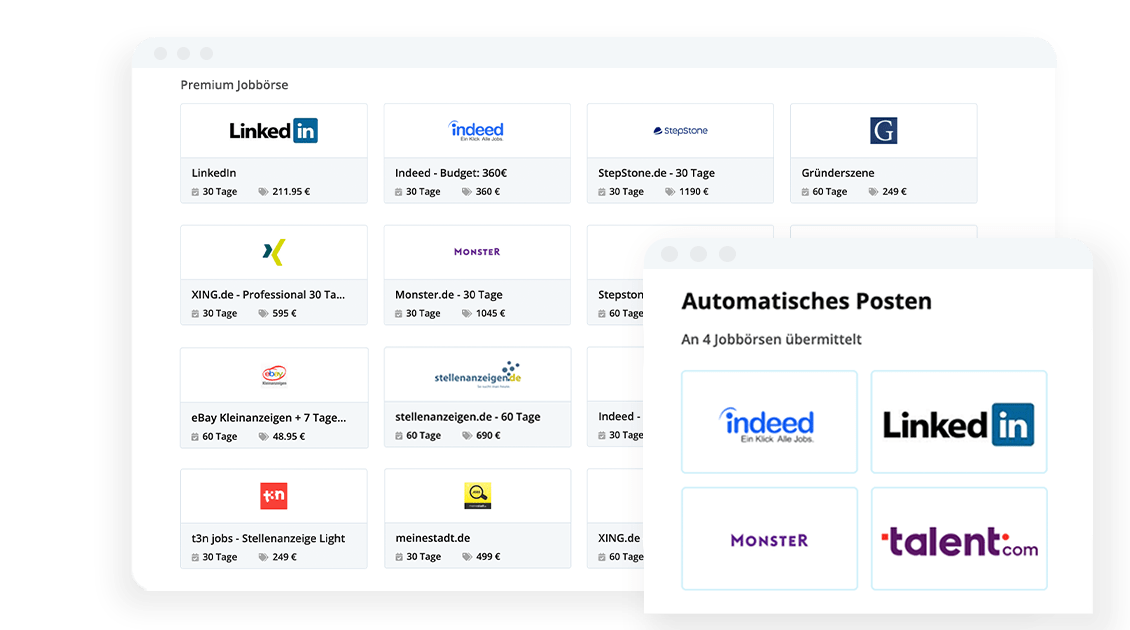
Attract top talent
Learn strategies to attract top talent and build a strong candidate pipeline.
Read our guide10 great candidate sourcing strategies to find top talent
Finding excellent candidates takes time and effort. But no matter how many resources you pump into candidate sourcing, you might still be left looking for the ideal ones. So, how do you source the best of the best?
This article covers 10 expert strategies that will help you find the right people for your open roles. We’ll also show you how to simplify the process with Personio, so you can take the hassle out of your recruitment process.
Why candidate sourcing is the key to quality hires
Candidate sourcing is one of the earliest steps in the hiring process. It’s a key part of proactive recruiting, which is essential for finding the right person for a position.
Sourcing potential candidates before a job post opens means you already have a pool of talent at your fingertips. By leveraging candidate sourcing techniques, you can reach the best possible candidates – even the ones who aren’t actively searching for a new role.
As Matt Collingwood, Recruitment Expert and Co-founder at Viqu explains: “Employers, especially small businesses with less manpower, often only start candidate sourcing when there is a live job. Or in situations where they’re working with a recruiter, they only tell the recruiter when they want the recruitment process to begin.”
This means your sourcing is limited to those candidates who are currently job hunting. However, he emphasises that “the best candidates are often passive, meaning they aren’t actively looking for a new job and don’t have a CV registered on job boards.”
Another big challenge is the issue of recruiters and hiring managers not having prior knowledge of the roles they’re hiring for, says Matt: “If we did, we would have additional time to build a pool of passive and active talent, giving the business a better spectrum of candidates.”
What do recruiters feel the biggest barriers to candidate sourcing are? Here’s what Eploy’s UK Candidate Attraction Report 2024 found:
A shortage of qualified candidates (61%)
Not enough diversity (34%)
Lower salaries than market average (31%)
Small recruitment advertising budget (26%)
Simplify candidate sourcing with smart applicant sourcing software

Quickly generate job postings, advertise on hundreds of job boards and manage the whole recruitment process with Personio’s recruitment software.
Learn more10 strategies for sourcing top talent
Finding top talent doesn’t need to feel like an impossible feat. Here are 10 strategies for talent sourcing, direct from hiring and recruitment experts.
1. Interview the hiring manager
You can gain a lot of knowledge and understanding about a position through an interview with the hiring manager. Gemma Hislop, HR Manager at Skale, recommends an in-depth chat, rather than merely reading a brief.
“You’re not going to have much chance of success if you don’t speak to the hiring manager first,” she says. She suggests asking the following questions so you can get a better handle on what the role entails:
What does success look like in this role?
What are the consequences of not filling this role?
What is the ideal candidate?
What would be their specific background or company?
Ultimately, you should focus on: Who is doing a good job at this and what do they have that we should channel in other candidates?
2. Use specialised applicant sourcing software
Manual applicant tracking and sourcing is cumbersome, time-consuming and error-prone. But by using specialised software, you can create custom career pages and post new positions on hundreds of premium job boards in just a click.
These tools also help you keep your applicants organised, minimising admin work so you can focus on finding more creative ways to seek and reach out to potential candidates. This also gives you more time to nurture relationships that can lead to successful hires.

3. Build a candidate database
Another benefit of using recruitment software is it helps you keep a record of all the people you connect with. You can log their details and notes on your interactions with them in one place, making it easier to keep track of the conversations you’ve had with potential candidates.
Make sure the software you use is GDPR-compliant or meets the 2018 Data Protection Act, as you need to be careful of what details you store, how and for how long to stay compliant. You also need to let people know that you’re storing their data and what you intend to do with it.
Personio is fully compliant with GDPR and UK data protection laws which makes it easy for you to stay compliant, too.
4. Reach out to former applicants
You likely have a pipeline of people who previously applied for roles, so leverage this resource when looking for candidates. You just might find the person who’s perfect for the role you’re trying to fill, even though they weren’t the right fit in the past.
For this strategy to be successful, you need to be intentional about how you treat rejection in your hiring process. Provide applicants with personalised feedback, stick to deadlines and keep communication channels open to nurture these relationships.
Pro tip: Instead of manually logging former applicant data, use specialised software that will help you consolidate this information so it’s easier to update and access.
5. Build relationships with potential candidates
While you need to nurture relationships with people who already applied for your roles, you also need to build rapport with all candidates, regardless of where they are in their careers.
You might find that while a prospective hire doesn't fit any position you currently have on your books, they may do so in the future. They likely also have access to a network of other candidates they can refer to you, which may lead you to the exact profile you’ve been looking for.
Plus, if you treat potential candidates with consideration and take the time to build relationships with them, word will spread about your company’s considerate and empathetic approach to recruitment and selection – which could even result in candidates coming directly to you.
6. Be strategic about direct outreach
Direct outreach is a manual process, and there’s no way to automate a personalised phone call or email. But making time for it is one of the best ways to boost your sourcing efforts. However, we understand that it’s time-consuming, so it’s important to be strategic about it.
Gemma recommends headhunting on LinkedIn, where you can filter potential candidates by different titles, skills, industries and locations. This makes it easy to find people for current and future job openings.
7. Take the time to develop effective job descriptions
Even if someone is the perfect fit for one of your roles, they may not be aware of it if your job description doesn’t accurately reflect the position, as Matt explains:
“When targeting active candidates, meaning those who are actively job searching, it’s important to place a lot of consideration on the keywords you use in your job descriptions. Doing so can increase your chances of your job coming up at the top of a candidate’s job board searches.”
He also recommends A/B testing multiple job descriptions to see what your candidates respond best to. This can help you optimise your entire recruitment process in order to secure the best candidates.
“Lots of businesses won’t take a step back to ask themselves what a candidate will want from the role. Instead, they focus on what sort of person they want. This often translates into a job description that doesn’t sell the business as a good employer, which puts them at a huge disadvantage.”
–Matt Collingwood, Recruitment Expert and Co-founder at Viqu
8. Cast your recruiting net far and wide
While targeted recruiting is important, it’s also a good idea to search across a large range of job boards, social networks and other sources where your potential candidates are likely to be. After this, you can focus on narrowing down the options based on the results you get.
With specialised applicant sourcing software like Personio, you can post across 15+ free job boards and run premium campaigns on over 600 boards across Europe for both generalist and specialist roles. Then, you can use the software to evaluate which channels are working best so you can be more strategic about your efforts.
9. Incentivise employee referrals
By encouraging your people to share job openings with their networks, whether via email, word of mouth, or social media, you’re more likely to end up with more quality candidates. Why? Because your employee’s networks are often largely made up of people with skills, qualifications and experience similar to theirs.
Money is a common incentive in employee referral schemes, but you can get creative and offer alternative rewards, like additional days off. Just make sure that whatever you’re offering is incentive enough for people to take the time to refer candidates to your organisation.
10. Track sourcing and recruiting metrics
Recruitment CRM software can help you track a number of valuable metrics, including:
Candidate source (i.e. job board, LinkedIn, referral)
Funnel conversion rate
Offer acceptance rate
Time to hire
You can use these metrics to further refine your recruitment methods. So if you see that the hires who stick around for longer come from your employee referral program, it may be worth investing more in it to incentivise even more personal recommendations from your team.
Also be sure to track quantifiable metrics like turnover rate in the first 90 days to gauge how successful your placements are. If your candidates are churning frequently within the first three months in their new role, it’s time to evaluate and improve your hiring and candidate-sourcing process.

Reduce your time to hire by 24% with Personio
Personio helps you find and reach out to potential candidates quicker so you can match the right people to the right position with less effort.
Our recruitment software lets you create, publish and manage open positions in a centralised location, plus track the metrics that matter most, like offer acceptance rate and time to hire. You can also assign tasks to various people in your organisation so no recruitment tasks slip through the cracks.
By automating and centralising the process, you can spend less time on manual tasks that bog you down and more time on efforts that move the needle – like direct outreach and relationship building.
FAQs
How do you automate candidate sourcing?
You can automate candidate sourcing by using recruitment software. Personio, for example, lets you bulk post job listings on over 15 free boards and 600+ paid boards in one go. You also get access to analytics that show you which channels bring in the best results, making it easy to refine your efforts and maximise your budget.
What are the most common sources of finding candidates?
The most common sources of finding candidates include social media platforms like LinkedIn and job boards. You can also seek out potential candidates at job fairs, as well as school and university programmes.
Another way to find candidates is a referral programme, where you incentivise team members to recommend ex-colleagues, friends, family members and acquaintances that could be a good fit for your open roles.
What is a direct source candidate?
A direct source candidate is someone hired by a business without the help of a third-party recruiter.
One of the benefits of direct candidate sourcing is that you understand your company and its culture better than an external recruiter might. This means you can create job listings that accurately reflect what benefits the company offers and what the job entails.
